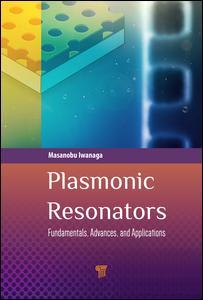Plasmonic Resonators Fundamentals, Advances, and Applications
Auteur : Iwanaga Masanobu

Plasmonic resonators, composed of metallic micro- and nanostructures, belong to the category of excited-state physics on resonances from gigahertz to petahertz. Dynamical physics is in contrast to ground-state physics, which includes thermal states, and is connected to diverse applications to enhance existing photo-induced effects and phenomena such as plasmon-enhanced photoluminescence and Raman scattering. This book has three main aims: to provide fundamental knowledge on plasmonic resonators, to explain diverse plasmonic resonators, and to stimulate further development in plasmonic resonators.
Plasmon-related studies, which are sometimes called plasmonics and include a substantial portion of metamaterials, have shown significant development since the 1980s. The piled-up results are too numerous to study from the beginning, but this book summarizes those results, including the history (past), all the possible types of plasmonic resonators (present), and their wide range of applications (future). It provides the basics of plasmons and resonant physics for undergraduate students, the systematic knowledge on plasmonic resonators for graduate students, and cutting-edge and in-depth information on plasmon-enhancement studies for researchers who are not experts in plasmonics and metamaterials, thereby benefitting a wide range of readers who are interested in the nanotechnology involving metallic nanostructures.
Introduction. Plasma frequency. Optical constants in metals. Metal–Insulator Interface where SPPs emerge. Brief overview of the history. Numerical methods. Nanofabrication methods. Chapter summary. Response Function Theory. Classical model for response function. Quantum mechanical description for response function. Spectral theory. Generalized theory for response function. Chapter summary. Plasmonic Resonators. Plasmonic waveguides. Nanoparticle plasmonic resonators. Nanoparticle-assembled plasmonic resonators. Single-layer lattices. Collective oscillation associated with longitudinal component in plasmonic resonators. Plasmonic resonators of simply stacked structures. Plasmonic resonators with chirality. Plasmonic resonators of stacked complementary (SC) structures. Perfect absorbers. Chapter summary. Nonlocality on Plasmonic Resonances. Nonlocal responses in far-field spectra. Nonlocal responses in near-field scattering. Optical nonlocality in plasmonic resonators. Chapter summary. Plasmonic Enhancement. Principles of Plas*. Purcell effect. PlasPL. Surface-plasmon-amplified stimulated emission resonators (SPASER). Strong coupling of plasmons with excitons and other resonances. PlasRaman. PlasCat. PlasNLO. Other Plas*. IR emitters. Chapter summary. Future Prospects. Status after two decades since the era of nanotechnology. Directions being opened. Challenges in near future. Concluding remarks.
Masanobu Iwanaga graduated from Kyoto University, Japan, in 1998 and received his doctorate from the same university in 2003. Since then, he was an assistant professor at the Department of Physics, Tohoku University. Now, he is affiliated to the National Institute for Materials Science (NIMS), Japan, which he joined in 2009.
Date de parution : 08-2016
15.2x22.9 cm
Disponible chez l'éditeur (délai d'approvisionnement : 15 jours).
Prix indicatif 122,56 €
Ajouter au panierThèmes de Plasmonic Resonators :
Mots-clés :
Top View SEM Image; resonance; SEM Image; nonlocal; Gap Plasmons; response; Plasmonic Waveguide; relative; Dispersion Diagram; permittivity; IR Emitter; dispersion; Nonlocal Responses; diagrams; Au NPs; dielectric; Local Plasmon; function; Ultrafast Response; fano; Resonant Energy; Xy Section; Negative Refractive Index; FDTD Method; Ag Single Crystal; Plasma Frequency Ωp; Waveguide Modes; Babinet’s Principle; Spp Dispersion; Hy Components; SOI Substrate; Te Polarization; Air Holes; Au Nanorod; Ez Component



